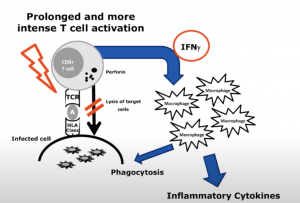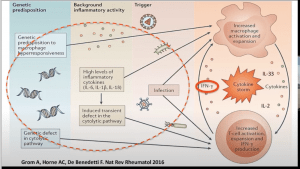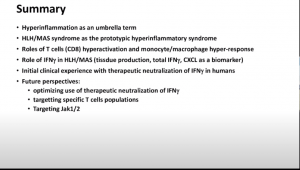Today’s IUIS-Immunopaedia-Frontiers Webinar highlights is on a talk by Fabrizio De Benedetti (paediatric) physician scientist on his research on hyperinflammation. De Benedetti’s research activity focuses on the role of inflammatory cytokines. His research led to the identification of novel biomarkers of disease activity and prognosis in several paediatric rheumatic diseases and the identification of novel therapeutic targets he designed and led several international clinical trials of novel biologicals. (Source: IUIS Website)
I n the IUIS-Immunopaedia-Frontiers in Immunology Webinar he gave examples of clinical presentations and laboratory features of hyper-inflammation with a focus on hemophagocytic lymphohistiocytosis (HLH) and macrophage activation syndrome (MAS). He also discussed Pathogenic mechanisms and the involvement of cytokine networks in different forms of hyper-inflammation, as well as conventional and novel targeted therapeutic approaches. Highlights of his talk include:
n the IUIS-Immunopaedia-Frontiers in Immunology Webinar he gave examples of clinical presentations and laboratory features of hyper-inflammation with a focus on hemophagocytic lymphohistiocytosis (HLH) and macrophage activation syndrome (MAS). He also discussed Pathogenic mechanisms and the involvement of cytokine networks in different forms of hyper-inflammation, as well as conventional and novel targeted therapeutic approaches. Highlights of his talk include:
- Brief on the definitions and examples of autoimmunity (triggered by adaptive immunity), auto-inflammation (triggered by adaptive immunity) and hyper-inflammation (triggered by innate and adaptive immunity).
- He also gave an overview on COVID-19 immunopathology includes hyper-inflammation.
 Mechanism of HLH : prolonged T cell activation which activates cytokine storm via the overproduction of IFN-g, and the potential treatment of paediatric HLA using anti-IFNg (emapalumab in clinical trial testing) (Locatelli et al. NEJM). Findings by Locatelli et al. demonstrated a good complete (26%) and partial (30%) response rate.
Mechanism of HLH : prolonged T cell activation which activates cytokine storm via the overproduction of IFN-g, and the potential treatment of paediatric HLA using anti-IFNg (emapalumab in clinical trial testing) (Locatelli et al. NEJM). Findings by Locatelli et al. demonstrated a good complete (26%) and partial (30%) response rate.- IFNg is not the only molecule involved in HLH, he also provided data that highlighted a role of IL-2 and IL-33.
- He also gave an overview of how paediatric rheumatoid arthritis and HLA are associated with CXCL9 and IFNg induced hyperinflammation, and IL-6 and IL-18 activated MAS.
- Finally, he gave multiple examples of the clinical potential of IFNg blockade in treatment of HLH and MAS.
- Summary of all talking points of the webinar are below.
Summary by Cheleka Anne-Marie Mpande











